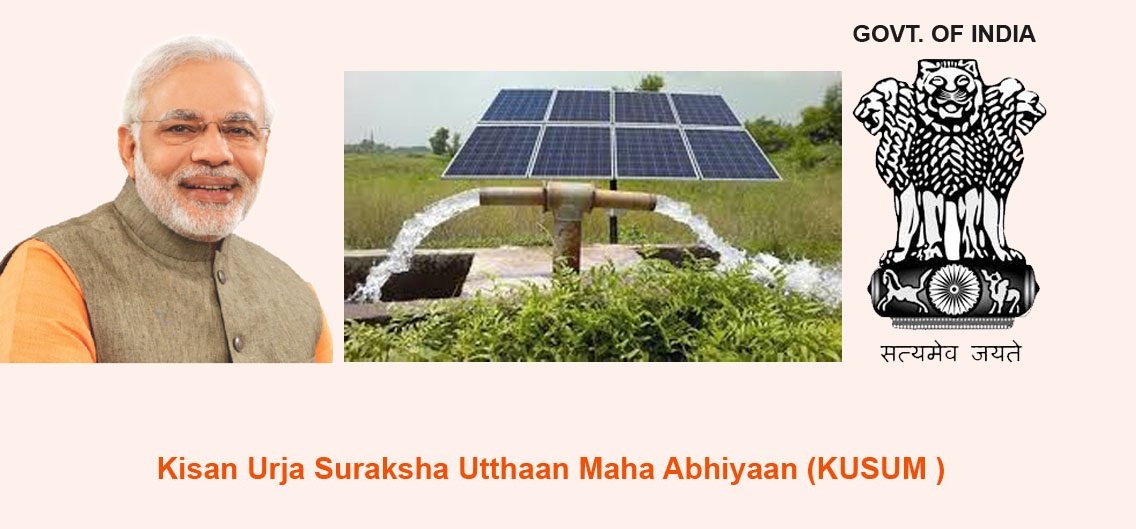
PM-KUSUM
CONTEXT
Recently, the first farm-based solar power plant under the Prime Minister’s Kisan Urja Suraksha Evam Utthan Mahabhiyan (PM-KUSUM) scheme has come up in Jaipur (Rajasthan) district’s Kotputli tehsil with a provision for production of 17 lakh units of electricity every year.
MORE ABOUT KUSUM
Kusum Scheme implemented by – The Ministry responsible for this scheme is the New and Renewable Energy Ministry.
It aims to add a solar capacity of 25,750 MW by 2022. The proposed scheme consists of
three components:
Component A – 10,000 MW of Decentralized Ground Mounted Grid Connected Renewable Power Plants.
o Renewable power plants of capacity 500 KW to 2 MW will be setup by individual farmers/cooperatives/panchayats /farmer producer organisations (FPO) on their barren or cultivable lands referred as Renewable Power Generator (RPG).
o The power generated will be purchased by the DISCOMs at Feed in tariffs determined by respective SERC.
o The scheme will open a stable and continuous source of income to the rural land owners.
Performance Based Incentives @ Rs. 0.40 per unit for five years to be provided to DISCOMs.
Component B – Installation of standalone Solar Powered Agriculture Pumps.
o Individual farmers will be supported to install standalone solar pumps of capacity up to 7.5 Horsepower (HP).
o It will be mandatory to use indigenously manufactured solar panels with indigenous solar cells and modules.
o Centre and state to share 30 per cent of pump cost each; farmer to provide the remaining 40 per cent (can access bank loan for up to 30 per cent of the cost)
Component C – Solarisation of Grid-connected Solar Powered Agriculture Pumps.
o Individual farmers will be supported to solarise pumps of capacity up to 7.5 HP.
o Solar PV capacity up to two times of pump capacity in kW is allowed under the scheme.
o The farmer will be able to use the generated energy to meet the irrigation needs and the excess available energy will be sold to DISCOM.
o This will help to create an avenue for extra income to the farmers, and for the States to meet their RPO targets.
The Scheme will have substantial environmental impact in terms of savings of CO2 emissions.
BENEFITS OF SCHEME
The scheme will open a stable and continuous source of income to the rural land owners for a period of 25 years by utilisation of their dry/uncultivable land.
Further, in case cultivated fields are chosen for setting up solar power project, the farmers could continue to grow crops as the solar panels are to be set up above a minimum height.
The scheme would ensure that sufficient local solar/ other renewable energy based power is available for feeding rural load centres and agriculture pump-set loads, which require power mostly during the day time.
As these power plants will be located closer to the agriculture loads or to electrical substations in a decentralized manner, it will result in reduced Transmission losses for STUs and Discoms.
Moreover, the scheme will also help the Discoms to achieve the RPO(Renewable Energy Purchase Obligation) target.
The solar pumps will save the expenditure incurred on diesel for running diesel pump and provide the farmers a reliable source of irrigation through solar pump apart from preventing harmful pollution from running diesel pump. In light of the long waiting list for electric grid connection, this scheme will benefit 17.5 lakh farmers over a period of four years, without adding to the grid load.
Benefits to states
o Promotes decentralised solar power production, and reduces transmission losses.
o A potential way to reduce their subsidy outlay towards irrigation.
Environmental Benefits – Expansion of the irrigation cover by providing decentralized solar-based irrigation and moving away from polluting diesel.
ISSUES WITH KUSUM
Logistics Issue – There is a matter of domestic availability of equipment itself. While pumps are not a challenge for domestic suppliers, the availability of solar pumps is still an issue.
o Further, due to the strict DCR (Domestic Content Requirements), the suppliers of solar equipment have to raise the domestic cell sourcing. However, there isn’t enough domestic cell manufacturing capacity.
Omission of Small and Marginal Farmers – There has been the relative omission of small and marginal farmers, as the scheme focuses on pumps of 3 HP and higher capacities.
o It is due to this, solar pumps are not reaching the majority of farmers, as nearly 85% of them are small & marginal.
o Also, the reality of low water tables, especially in North India and parts of South India, which make small-sized pumps limiting for the farmer.
Depleting Water Tables – Due to power subsidies, the recurring cost of electricity is so low that farmers keep on pumping water and the water table is going down.
o In a solar installation, it becomes a more difficult job to upgrade to higher capacity pumps in case the water table falls because one will have to add new solar panels which are expensive.
Way Forward
Bring States Together – Consensus between the Centre and States is the key to the success of this decentralized solar power scheme. Any reform in India’s power space cannot take place unless there is consensus between the Centre, States, and stakeholders.
Lucrative Solar Energy Pricing – For effective implementation and serious participation by stakeholders, the scheme should be more attractive in terms of benchmark prices in view of the challenges on account of higher costs of implementation and comprehensive maintenance.
Sustainable Farming – Apart from switching to solar power, farmers should also switch over to drip irrigation mode which saves water and power with increased crop output.
